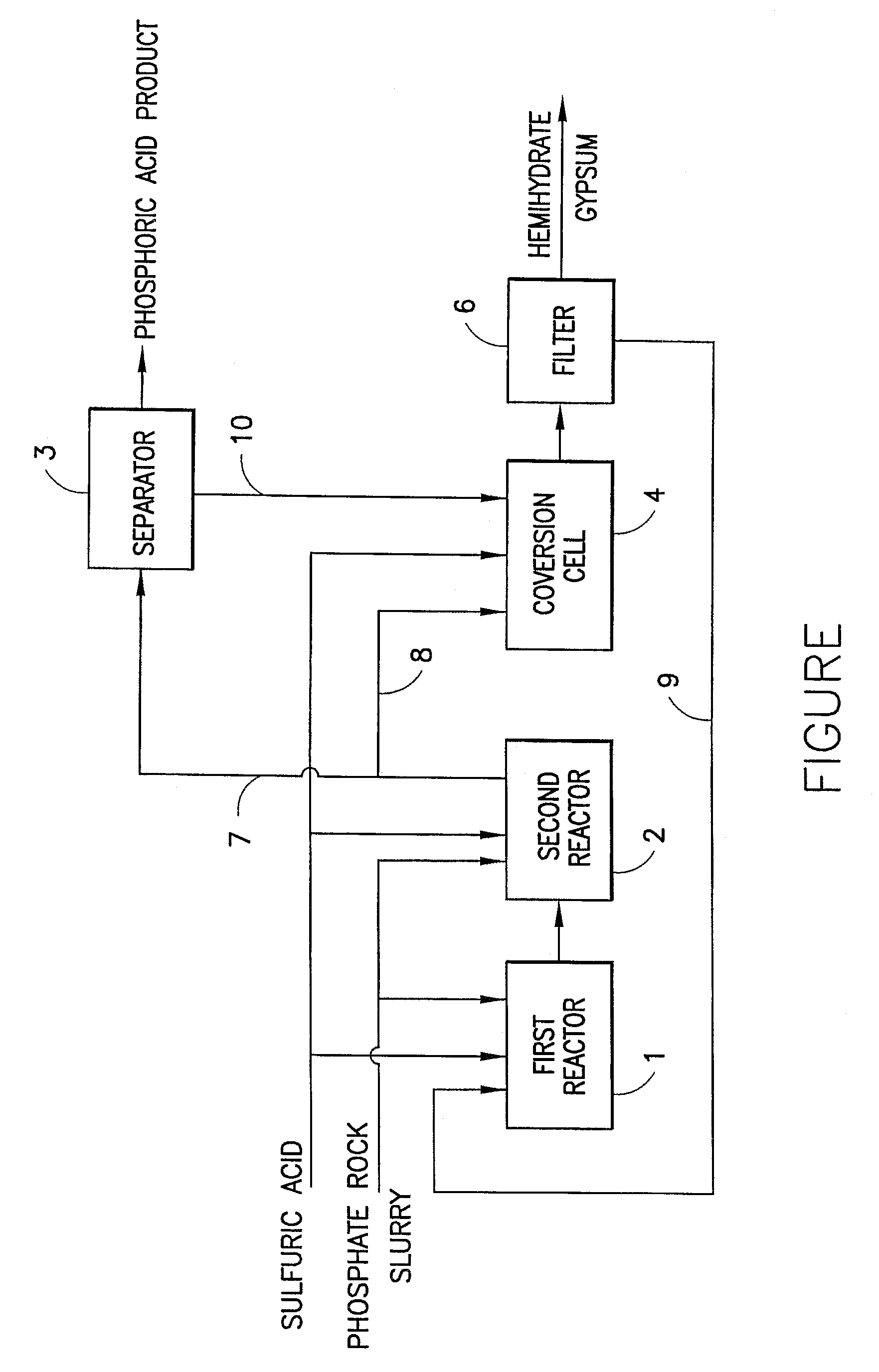Method of preparing wet process phosphoric acid
a technology of phosphoric acid and wet process, which is applied in the direction of inorganic chemistry, chemistry apparatus and processes, calcium/strontium/barium sulfates, etc., can solve the problems of low recovery efficiency, high cost, and inability to industrialize anhydrous process, so as to reduce the loss of p2o5, improve the crystallization condition, and maximize the concentration of free sulfuric acid
- Summary
- Abstract
- Description
- Claims
- Application Information
AI Technical Summary
Benefits of technology
Problems solved by technology
Method used
Image
Examples
example 1
[0015]1. In the first reactor, feeding phosphate rock slurry, sulfuric acid, and recycled low-concentration phosphoric acid with 27.1% of P2O5 from filter to conduct decomposition reaction; their weight ratio is 1:0.75:1.6; the molar ratio of phosphate rock slurry to sulfuric acid is 1:5; in the first reactor, feeding amount of the slurry and that of the sulfuric acid is respectively 71 and 72 wt. % of their total feeding amount in the process; the reaction temperature is controlled at 79° C.; the ratio of liquid to solid is 2.55; the concentration of SO3 in reaction solution is 0.064 g / L; the reaction time is 1.8 hour; the concentration of P2O5 in reaction solution is 28.9%.[0016]2. In the second reactor, feeding the first reaction solution and the other 29% of phosphate rock slurry and 28% of sulfuric acid; making reaction complete; in the second reactor, the reaction temperature is controlled at 74° C.; the ratio of liquid to solid is 2.59; the concentration of SO3 in reaction so...
example 2
[0020]1. In the first reactor, feeding phosphate rock slurry, sulfuric acid, and recycled low-concentration phosphoric acid with 27.9% P2O5 from filter; their weight ratio is 1:0.68:1.4; the molar ratio of phosphate rock slurry to sulfuric acid is 1:5; in the first reactor, feeding amount of the slurry and that of sulfuric acid is respectively 78 and 80 wt. % of their total amount; the reaction temperature is controlled at 83° C.; the ratio of liquid to solid is 2.41; the concentration of SO3 in reaction solution is 0.053 g / L; the reaction time is 2 hour; the concentration of P2O5 in reaction solution is 29.1%.[0021]2. In the second reactor, feeding the first reaction solution and the other 22% of phosphate rock slurry and 20% of sulfuric acid; making reaction complete; in the second reactor, the reaction temperature is controlled at 78° C.; the ratio of liquid to solid is 2.57; the concentration of SO3 in reaction solution is 0.031 g / L; the reaction time is 1.6 hour; the concentrat...
PUM
| Property | Measurement | Unit |
|---|---|---|
| temperature | aaaaa | aaaaa |
| temperature | aaaaa | aaaaa |
| temperature | aaaaa | aaaaa |
Abstract
Description
Claims
Application Information
 Login to View More
Login to View More - R&D
- Intellectual Property
- Life Sciences
- Materials
- Tech Scout
- Unparalleled Data Quality
- Higher Quality Content
- 60% Fewer Hallucinations
Browse by: Latest US Patents, China's latest patents, Technical Efficacy Thesaurus, Application Domain, Technology Topic, Popular Technical Reports.
© 2025 PatSnap. All rights reserved.Legal|Privacy policy|Modern Slavery Act Transparency Statement|Sitemap|About US| Contact US: help@patsnap.com


